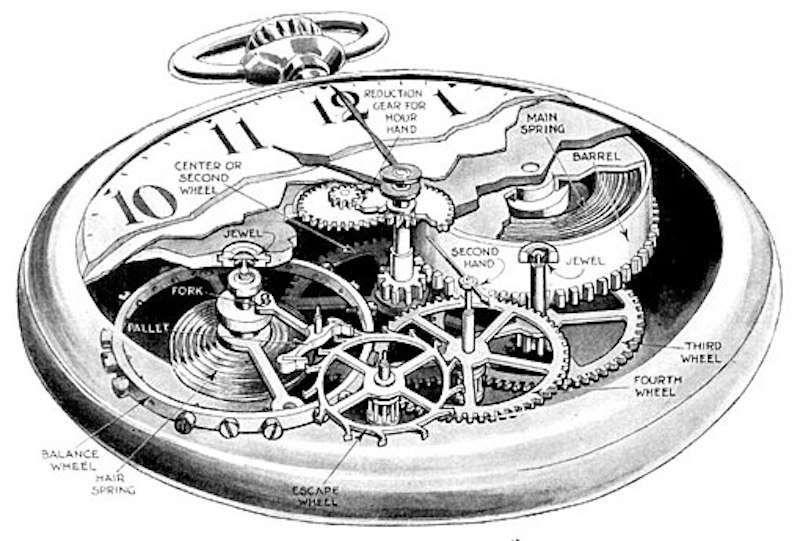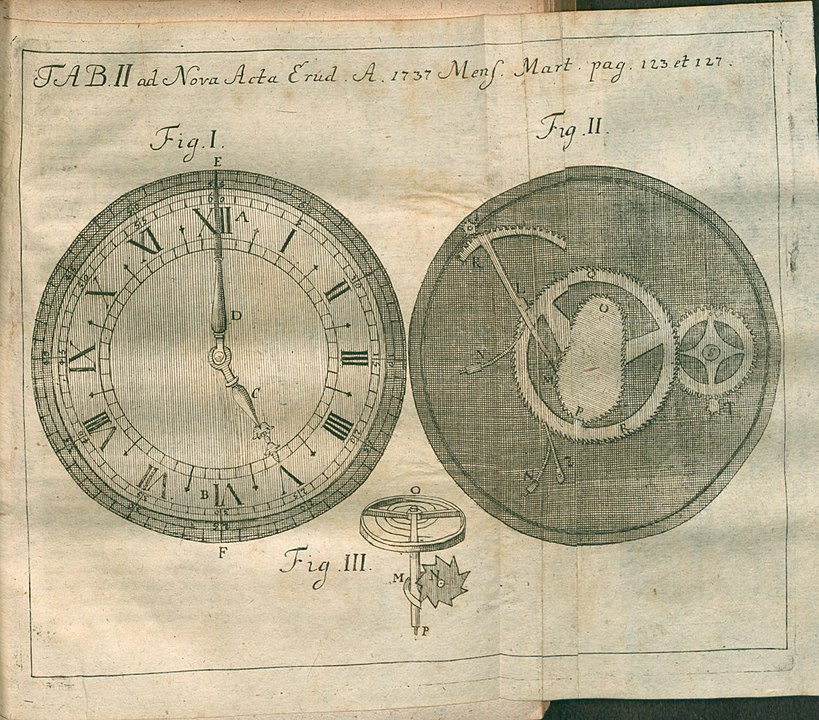The history of luxury watches reflects societal changes and progress, showcasing the evolution of individuals' thoughts, achievements, and aspirations. From traditional pocket watches to advanced high-tech timepieces, these watches have contributed to shifts in lifestyle, wealth utilization, and technological advancements. Let's explore this captivating narrative further.
Key Points
- The Birth of Timekeeping
- The Advent of Mechanical Watches
- The Industrial Revolution and the Birth of Luxury Watch Brands
- The 20th Century: The Era of Wristwatches and Technological Advancements
- The Modern Luxury Watch Market
- The Future of Luxury Watches
- Conclusion
Contents,
The Birth of Timekeeping

(winding watch, via Wikipedia)
The history of luxury watches is a captivating journey that begins in the 16th century.
This was a time when watches transitioned from being items of practicality to symbols of status and wealth.
The earliest watches were mechanical and powered by winding a mainspring which turned gears, moving the hands on the watch face.
These early timepieces were often worn around the neck or carried in the pocket and were considered a luxury only the wealthy could afford.
The Advent of Mechanical Watches

In the world of luxury watches, brands like Rolex (@Rolex), were founded in 1905 in London, England.
Rolex watches became famous because they were very accurate and reliable. This made them popular with people who go on adventures and explore new places.
In 1927, a big event happened. A woman named Mercedes Gleitze wore a Rolex Oyster watch while she swam across the English Channel. This was the first time a woman did this, and it made Rolex even more famous.
Our history of partnerships began in 1927 when Mercedes Gleitze helped to prove the resistance to water of the Rolex Oyster. Since then, we have partnered with those driven, like us, to push back the limits of the possible. More https://t.co/hAlIipHGq2 #WorldOfRolex #Perpetual pic.twitter.com/KwRmKphGd7
— ROLEX (@ROLEX) August 8, 2020
Omega, founded in 1848, is famous for its association with NASA and the first moon landing.
🇺🇲OMEGA Gold Speedmaster
This one was offered to Nixon by OMEGA, working with NASA to create the pieces to commemorate the 1969 Moon Landing.
The first 2 were to be given to Nixon and Vice President Agnew.
Both were turned down for values exceeding the allowable gift amount. pic.twitter.com/w6PxyYv9Ul
— 💓Wrist Watch Porn⌚ (@wristwatchbliss) November 14, 2018
Patek Philippe is a company that started in 1839 in Geneva, Switzerland. They quickly became famous for their new and detailed watch designs.
One of their biggest achievements was making the world's first wristwatch with a calendar that never ends in 1925. Even today, people want to own Patek Philippe watches. Some of their special watches that are only made in small numbers can be sold for millions of dollars at auctions.
First launched in 1985, reference 3940 replaced the existing perpetual calendar wristwatch, reference 3450. Featuring a circular-shaped case, the watch presented a decidedly more "modern" and less angular appearance than its predecessor. pic.twitter.com/5AZQLtgbCa
— Horology & History (@horologyhistory) October 29, 2022
These brands have annual revenues in the billions, reflecting the high demand for their exquisite timepieces. Becoming a watchmaker in these prestigious companies requires rigorous training and a deep passion for the craft.
It is a profession that combines technical skill with artistic creativity, as each watch is a masterpiece of design and engineering.
The process of creating a luxury watch involves hundreds of intricate steps, from the design phase to the final assembly, each requiring a high level of precision and attention to detail.
The Industrial Revolution and the Birth of Luxury Watch Brands

Switzerland is often considered the heart of luxury watchmaking. This is due to the country's long history of craftsmanship, precision, and innovation in the field.
Swiss watchmakers are renowned for their skill and expertise, often undergoing extensive training programs that can last several years. This commitment to excellence is evident in the superior quality of Swiss-made watches.
The Swiss watchmaking industry has a rich history, with many of the world's most prestigious brands, including Patek Philippe, Audemars Piguet, and Vacheron Constantin, calling Switzerland home.
Patek Philippe
Founded in 1839, Patek Philippe is a testament to watchmaking excellence. Known for its perpetual calendar, chronograph, and minute repeater watches, the brand has made significant contributions to horological innovation.
Patek Philippe is also famous for creating the most complicated mechanical watch ever made, the Calibre 89, which has 33 complications.
This remarkable timepiece took nine years to design and five years to manufacture, demonstrating the brand's commitment to craftsmanship and innovation.
Audemars Piguet
Audemars Piguet, established in 1875, has left an indelible mark on the world of luxury watches. The brand is renowned for introducing the Royal Oak in 1972, the world's first luxury sports watch.
This bold move revolutionized the industry and cemented Audemars Piguet's place in watchmaking history.
The Royal Oak's distinctive octagonal bezel and integrated bracelet, combined with its high-quality mechanical movement, set a new standard for luxury sports watches.
Vacheron Constantin
With an uninterrupted history dating back to 1755, Vacheron Constantin is one of the oldest watch manufacturers in the world. The brand is known for its highly artistic designs and high-quality watches, reflecting a perfect balance of tradition and innovation. Vacheron Constantin's timepieces are often characterized by their intricate engravings and decorations, which are all done by hand by skilled craftsmen.
The 20th Century: The Era of Wristwatches and Technological Advancements

The 20th century saw the rise of wristwatches, which were initially popularized by the military. For instance, during World War I, soldiers found wristwatches to be far more convenient than pocketwatches in combat situations.
Brands like Omega and Rolex were quick to respond to this demand, creating robust, reliable wristwatches for military use. The Omega Seamaster and the Rolex Submariner are two iconic models that were originally designed for professional use but have since become popular luxury watches.
These models have evolved over the years, with modern versions featuring advanced materials and technologies while maintaining their classic design elements.
The Modern Luxury Watch Market

Today, luxury watches are more than just timekeeping devices; they are investments.
Limited edition models, iconic designs, and watches worn by celebrities often appreciate value over time. For instance, the Rolex Daytona owned by actor Paul Newman was sold at auction for $17.8 million in 2017, demonstrating the potential investment value of luxury watches.
This trend has led to the emergence of watch collecting as a form of investment, with collectors often seeking rare and historically significant pieces.
The Future of Luxury Watches
As we look to the future, industry experts predict that the allure of luxury watches will endure. According to Thierry Stern, President of Patek Philippe, "The desire for a mechanical watch, a beautiful object, will continue."
Despite the rise of smartwatches, the demand for traditional luxury watches, with their intricate mechanisms and timeless appeal, remains strong.
The future of luxury watches is likely to be characterized by a blend of tradition and innovation, with watchmakers continuing to push the boundaries of design and technology while maintaining the craftsmanship and artistry that define luxury watches.
Conclusion:
From the time they first appeared in the 16th century to now, luxury watches have always amazed us with their beauty, accuracy, and the skill it takes to make them.
They've changed from being useful tools to symbols of success, and now they're even seen as valuable things to invest in.
When we think about the future, there's one thing we can be sure of. The charm of luxury watches, where art, skill, and style come together, will always be there, no matter how much time passes.
Whether you've been collecting watches for a long time, or you're just starting to learn about them, the world of luxury watches has something for everyone.
